HCA 470 - Business Plan: SWOT Analysis & Action Plan for Mayo Clinic
VerifiedAdded on 2023/04/21
|17
|3082
|183
Report
AI Summary
This assignment presents a comprehensive business plan for the Mayo Clinic, beginning with a SWOT analysis identifying the organization's strengths, weaknesses, opportunities, and threats. Key strengths include its focus on research, innovation, and quality patient care, supported by an integrated medical record system. Weaknesses involve limited network reach and potential negative press. Opportunities lie in leveraging research discoveries, expanding the Mayo Clinic Care Network, and supporting staff development. Threats include healthcare reform changes, market consolidation, and competition for qualified practitioners. The plan proposes strategic goals such as expanding the Mayo Clinic Network and focusing on healthcare costs and quality. The action plan further suggests expanding women's health services in Phoenix, Arizona, to address local demographic needs and growing demand. This involves establishing a task force, securing funding, and developing relationships with vendors. The stakeholder analysis identifies key individuals and groups, including the Board of Trustees and executive leadership, and emphasizes the importance of effective communication for successful implementation. The plan aims to enhance the Mayo Clinic's impact by providing comprehensive, quality women's health services and contributing to the organization's mission of delivering the best patient care.
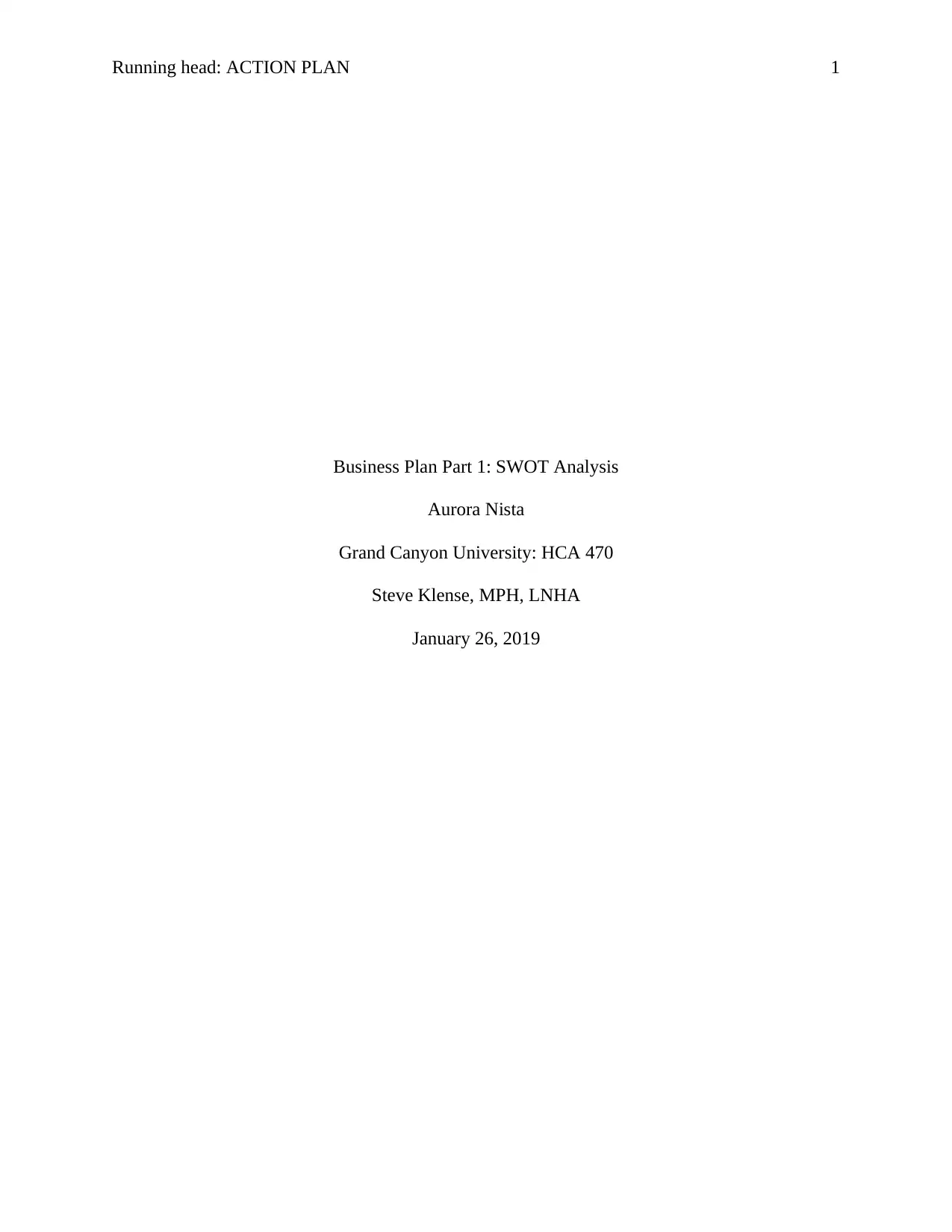
Running head: ACTION PLAN
Business Plan Part 1: SWOT Analysis
Aurora Nista
Grand Canyon University: HCA 470
Steve Klense, MPH, LNHA
January 26, 2019
1
Business Plan Part 1: SWOT Analysis
Aurora Nista
Grand Canyon University: HCA 470
Steve Klense, MPH, LNHA
January 26, 2019
1
Paraphrase This Document
Need a fresh take? Get an instant paraphrase of this document with our AI Paraphraser

Running head: ACTION PLAN
Business Plan Part 1: SWOT Analysis
Strategic planning is crucial to the success of a healthcare organization that need to keep
up to constant regulatory changes as well as internal and external contributing factors. Strategies
are developed to drive the focus of the organization in a horizontal manner that is measured in
years with the commitment of the major organizational resources (Moseley, 2009). In an effort to
satisfy and reward its stakeholders, fulfill its mission and vision, survive and thrive in the
healthcare industry, the Mayo Clinic has been a forerunner in their approach to patient care
through complex planning strategies.
Strengths
Mayo Clinic, the first and largest nonprofit medical group, continues to focus on research
and innovation with significant discoveries in the area of treatment and disease. Focusing on
quality in all areas of operations allows Mayo Clinic to remain dedicated to providing superior
care through accountability driven models for improving patient experience based on service
quality, improving service tools, education and training, and ongoing monitoring and control
(Kennedy, Fasolino & Gullen, 2014). The Integrated Medical Record System allows access to
patient information from any location as well as patient access to treatment and diagnosis
information, laboratory results, and scheduling systems.
Weaknesses
Narrow health care networks within the Mayo Clinic organization can result in a
decreased area of impact as other organizations may provide services to wider geographical
areas. Although the Mayo Clinic network size is impressive, treating around 1.3 million people
each year, there are areas being served by the network that requires patients to travel long
distances for hospital services in Minnesota (Diamond, 2017). Negative press can be difficult to
2
Business Plan Part 1: SWOT Analysis
Strategic planning is crucial to the success of a healthcare organization that need to keep
up to constant regulatory changes as well as internal and external contributing factors. Strategies
are developed to drive the focus of the organization in a horizontal manner that is measured in
years with the commitment of the major organizational resources (Moseley, 2009). In an effort to
satisfy and reward its stakeholders, fulfill its mission and vision, survive and thrive in the
healthcare industry, the Mayo Clinic has been a forerunner in their approach to patient care
through complex planning strategies.
Strengths
Mayo Clinic, the first and largest nonprofit medical group, continues to focus on research
and innovation with significant discoveries in the area of treatment and disease. Focusing on
quality in all areas of operations allows Mayo Clinic to remain dedicated to providing superior
care through accountability driven models for improving patient experience based on service
quality, improving service tools, education and training, and ongoing monitoring and control
(Kennedy, Fasolino & Gullen, 2014). The Integrated Medical Record System allows access to
patient information from any location as well as patient access to treatment and diagnosis
information, laboratory results, and scheduling systems.
Weaknesses
Narrow health care networks within the Mayo Clinic organization can result in a
decreased area of impact as other organizations may provide services to wider geographical
areas. Although the Mayo Clinic network size is impressive, treating around 1.3 million people
each year, there are areas being served by the network that requires patients to travel long
distances for hospital services in Minnesota (Diamond, 2017). Negative press can be difficult to
2

Running head: ACTION PLAN
overcome when the issues being brought up can make the organization seem as less than caring
for their patients at times.
Opportunities
Mayo Clinic is committed to healthcare research, which allows the organization to be the
lead for applying research discoveries into practice. The Mayo Clinic Care Network allows
outside providers and organizations to become part of the Mayo Care Network, gaining access to
the Mayo Clinic expertise and resources. The organization’s focus on supporting staff education
and career advancement can result in opportunities for attracting and retaining the best qualified
staff. Publicly reporting healthcare outcomes is a vital component of the quality of services
provided and progression. Mayo Clinic has reported net asset increases in the 2017 fiscal year
compared to previous periods as well as $66 million in cash and equivalents at year end (Mayo
Clinic Consolidated Financial Report, 2018).
Threats
Some of the threats include significant changes resulting from the healthcare reform, the
need for market consolidations, attracting highly qualified healthcare practitioners, and
understanding the impact of regional competitors. Gaining competitive advantage over
competitors can be a good motivator for increasing organizational focus on superior healthcare
services and highly specialized care.
Strategic Goals
Mayo Clinic’s extensive experience allows for a comprehensive approach to healthcare
and its sustainability. The issues of fragmentation and variation, overhauling current payment
methods to encourage the delivery of high-quality services and efficient patient treatments.
Understanding their strengths, weaknesses, threats, and opportunities can be the facilitator for
3
overcome when the issues being brought up can make the organization seem as less than caring
for their patients at times.
Opportunities
Mayo Clinic is committed to healthcare research, which allows the organization to be the
lead for applying research discoveries into practice. The Mayo Clinic Care Network allows
outside providers and organizations to become part of the Mayo Care Network, gaining access to
the Mayo Clinic expertise and resources. The organization’s focus on supporting staff education
and career advancement can result in opportunities for attracting and retaining the best qualified
staff. Publicly reporting healthcare outcomes is a vital component of the quality of services
provided and progression. Mayo Clinic has reported net asset increases in the 2017 fiscal year
compared to previous periods as well as $66 million in cash and equivalents at year end (Mayo
Clinic Consolidated Financial Report, 2018).
Threats
Some of the threats include significant changes resulting from the healthcare reform, the
need for market consolidations, attracting highly qualified healthcare practitioners, and
understanding the impact of regional competitors. Gaining competitive advantage over
competitors can be a good motivator for increasing organizational focus on superior healthcare
services and highly specialized care.
Strategic Goals
Mayo Clinic’s extensive experience allows for a comprehensive approach to healthcare
and its sustainability. The issues of fragmentation and variation, overhauling current payment
methods to encourage the delivery of high-quality services and efficient patient treatments.
Understanding their strengths, weaknesses, threats, and opportunities can be the facilitator for
3
⊘ This is a preview!⊘
Do you want full access?
Subscribe today to unlock all pages.

Trusted by 1+ million students worldwide
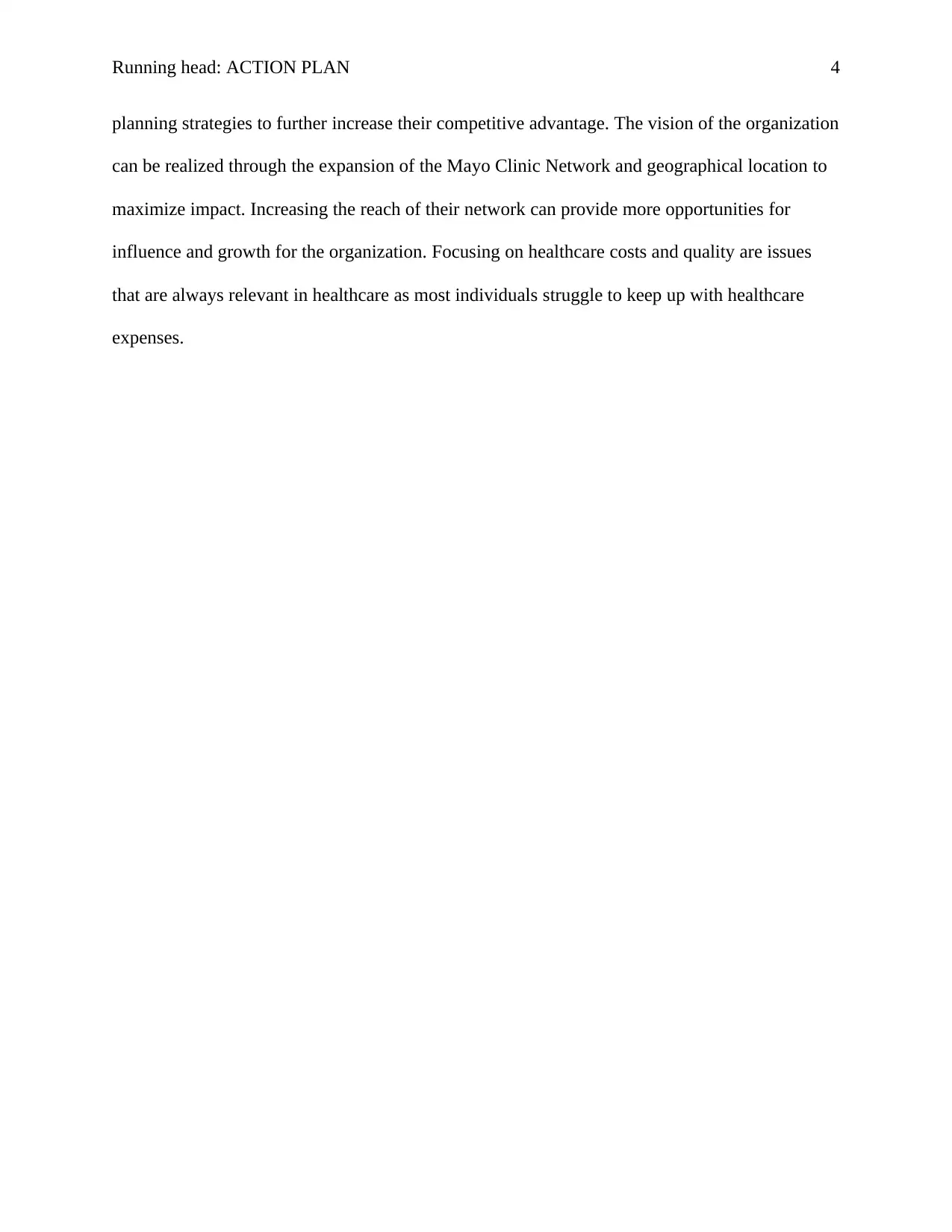
Running head: ACTION PLAN
planning strategies to further increase their competitive advantage. The vision of the organization
can be realized through the expansion of the Mayo Clinic Network and geographical location to
maximize impact. Increasing the reach of their network can provide more opportunities for
influence and growth for the organization. Focusing on healthcare costs and quality are issues
that are always relevant in healthcare as most individuals struggle to keep up with healthcare
expenses.
4
planning strategies to further increase their competitive advantage. The vision of the organization
can be realized through the expansion of the Mayo Clinic Network and geographical location to
maximize impact. Increasing the reach of their network can provide more opportunities for
influence and growth for the organization. Focusing on healthcare costs and quality are issues
that are always relevant in healthcare as most individuals struggle to keep up with healthcare
expenses.
4
Paraphrase This Document
Need a fresh take? Get an instant paraphrase of this document with our AI Paraphraser
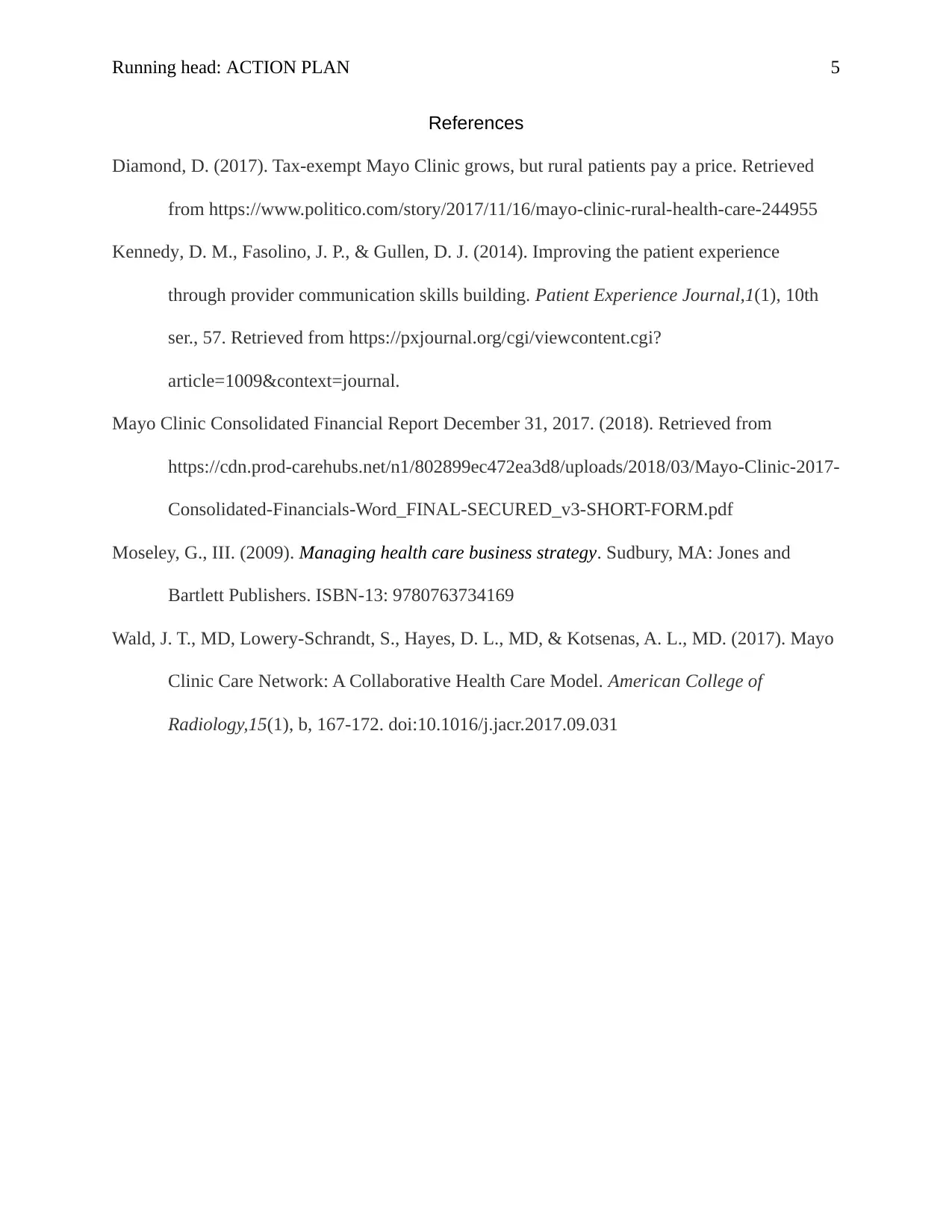
Running head: ACTION PLAN
References
Diamond, D. (2017). Tax-exempt Mayo Clinic grows, but rural patients pay a price. Retrieved
from https://www.politico.com/story/2017/11/16/mayo-clinic-rural-health-care-244955
Kennedy, D. M., Fasolino, J. P., & Gullen, D. J. (2014). Improving the patient experience
through provider communication skills building. Patient Experience Journal,1(1), 10th
ser., 57. Retrieved from https://pxjournal.org/cgi/viewcontent.cgi?
article=1009&context=journal.
Mayo Clinic Consolidated Financial Report December 31, 2017. (2018). Retrieved from
https://cdn.prod-carehubs.net/n1/802899ec472ea3d8/uploads/2018/03/Mayo-Clinic-2017-
Consolidated-Financials-Word_FINAL-SECURED_v3-SHORT-FORM.pdf
Moseley, G., III. (2009). Managing health care business strategy. Sudbury, MA: Jones and
Bartlett Publishers. ISBN-13: 9780763734169
Wald, J. T., MD, Lowery-Schrandt, S., Hayes, D. L., MD, & Kotsenas, A. L., MD. (2017). Mayo
Clinic Care Network: A Collaborative Health Care Model. American College of
Radiology,15(1), b, 167-172. doi:10.1016/j.jacr.2017.09.031
5
References
Diamond, D. (2017). Tax-exempt Mayo Clinic grows, but rural patients pay a price. Retrieved
from https://www.politico.com/story/2017/11/16/mayo-clinic-rural-health-care-244955
Kennedy, D. M., Fasolino, J. P., & Gullen, D. J. (2014). Improving the patient experience
through provider communication skills building. Patient Experience Journal,1(1), 10th
ser., 57. Retrieved from https://pxjournal.org/cgi/viewcontent.cgi?
article=1009&context=journal.
Mayo Clinic Consolidated Financial Report December 31, 2017. (2018). Retrieved from
https://cdn.prod-carehubs.net/n1/802899ec472ea3d8/uploads/2018/03/Mayo-Clinic-2017-
Consolidated-Financials-Word_FINAL-SECURED_v3-SHORT-FORM.pdf
Moseley, G., III. (2009). Managing health care business strategy. Sudbury, MA: Jones and
Bartlett Publishers. ISBN-13: 9780763734169
Wald, J. T., MD, Lowery-Schrandt, S., Hayes, D. L., MD, & Kotsenas, A. L., MD. (2017). Mayo
Clinic Care Network: A Collaborative Health Care Model. American College of
Radiology,15(1), b, 167-172. doi:10.1016/j.jacr.2017.09.031
5
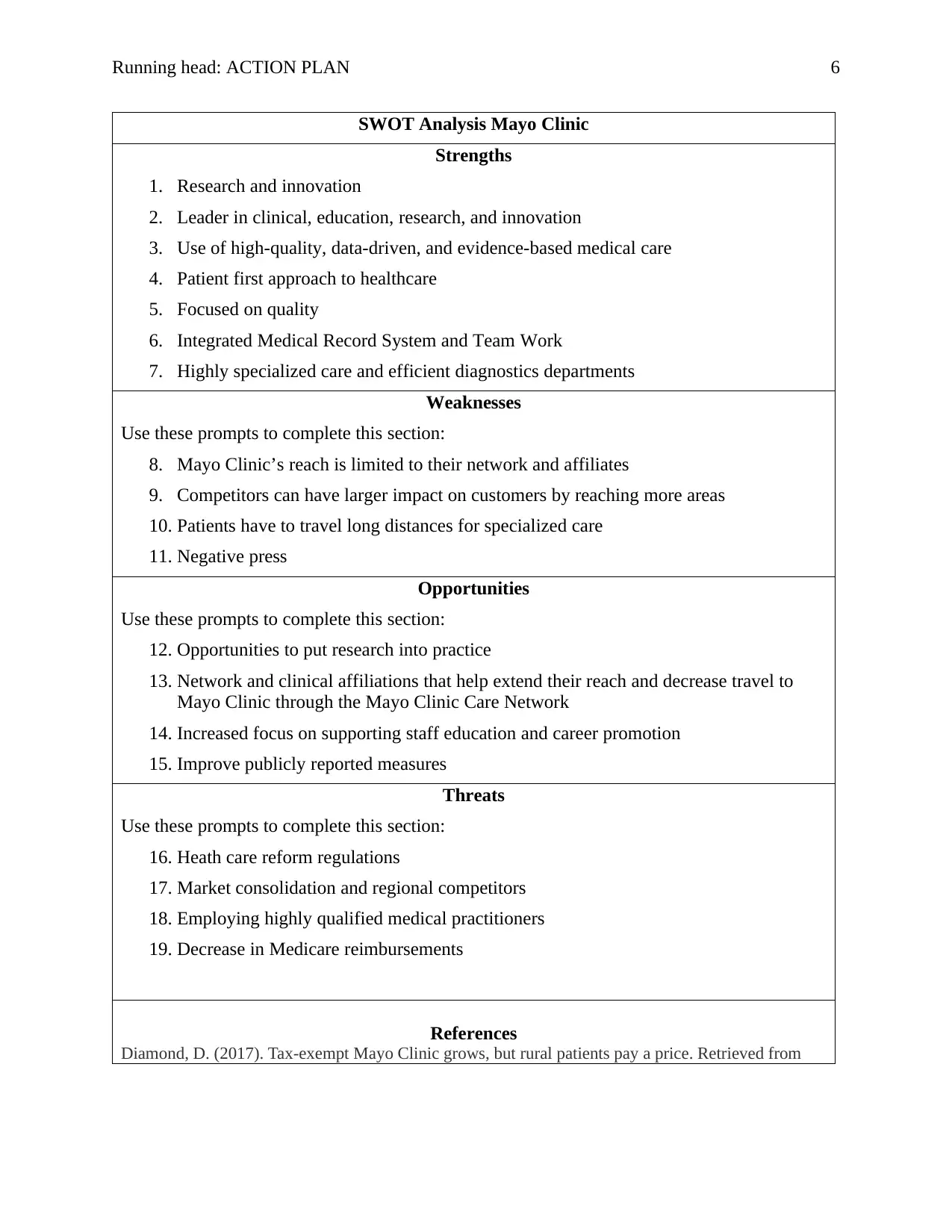
Running head: ACTION PLAN
SWOT Analysis Mayo Clinic
Strengths
1. Research and innovation
2. Leader in clinical, education, research, and innovation
3. Use of high-quality, data-driven, and evidence-based medical care
4. Patient first approach to healthcare
5. Focused on quality
6. Integrated Medical Record System and Team Work
7. Highly specialized care and efficient diagnostics departments
Weaknesses
Use these prompts to complete this section:
8. Mayo Clinic’s reach is limited to their network and affiliates
9. Competitors can have larger impact on customers by reaching more areas
10. Patients have to travel long distances for specialized care
11. Negative press
Opportunities
Use these prompts to complete this section:
12. Opportunities to put research into practice
13. Network and clinical affiliations that help extend their reach and decrease travel to
Mayo Clinic through the Mayo Clinic Care Network
14. Increased focus on supporting staff education and career promotion
15. Improve publicly reported measures
Threats
Use these prompts to complete this section:
16. Heath care reform regulations
17. Market consolidation and regional competitors
18. Employing highly qualified medical practitioners
19. Decrease in Medicare reimbursements
References
Diamond, D. (2017). Tax-exempt Mayo Clinic grows, but rural patients pay a price. Retrieved from
6
SWOT Analysis Mayo Clinic
Strengths
1. Research and innovation
2. Leader in clinical, education, research, and innovation
3. Use of high-quality, data-driven, and evidence-based medical care
4. Patient first approach to healthcare
5. Focused on quality
6. Integrated Medical Record System and Team Work
7. Highly specialized care and efficient diagnostics departments
Weaknesses
Use these prompts to complete this section:
8. Mayo Clinic’s reach is limited to their network and affiliates
9. Competitors can have larger impact on customers by reaching more areas
10. Patients have to travel long distances for specialized care
11. Negative press
Opportunities
Use these prompts to complete this section:
12. Opportunities to put research into practice
13. Network and clinical affiliations that help extend their reach and decrease travel to
Mayo Clinic through the Mayo Clinic Care Network
14. Increased focus on supporting staff education and career promotion
15. Improve publicly reported measures
Threats
Use these prompts to complete this section:
16. Heath care reform regulations
17. Market consolidation and regional competitors
18. Employing highly qualified medical practitioners
19. Decrease in Medicare reimbursements
References
Diamond, D. (2017). Tax-exempt Mayo Clinic grows, but rural patients pay a price. Retrieved from
6
⊘ This is a preview!⊘
Do you want full access?
Subscribe today to unlock all pages.

Trusted by 1+ million students worldwide

Running head: ACTION PLAN
https://www.politico.com/story/2017/11/16/mayo-clinic-rural-health-care-244955
Kennedy, D. M., Fasolino, J. P., & Gullen, D. J. (2014). Improving the patient experience through
provider communication skills building. Patient Experience Journal,1(1), 10th ser., 57.
Retrieved from https://pxjournal.org/cgi/viewcontent.cgi?article=1009&context=journal.
Mayo Clinic Consolidated Financial Report December 31, 2017. (2018). Retrieved from
https://cdn.prod-carehubs.net/n1/802899ec472ea3d8/uploads/2018/03/Mayo-Clinic-2017-
Consolidated-Financials-Word_FINAL-SECURED_v3-SHORT-FORM.pdf
Moseley, G., III. (2009). Managing health care business strategy. Sudbury, MA: Jones and
Bartlett Publishers. ISBN-13: 9780763734169
Wald, J. T., MD, Lowery-Schrandt, S., Hayes, D. L., MD, & Kotsenas, A. L., MD. (2017).
Mayo Clinic Care Network: A Collaborative Health Care Model. American College of
Radiology,15(1), b, 167-172. doi:10.1016/j.jacr.2017.09.031
Business Plan Part 2: Action Plan
Aurora Nista
Grand Canyon University: HCA-470
7
https://www.politico.com/story/2017/11/16/mayo-clinic-rural-health-care-244955
Kennedy, D. M., Fasolino, J. P., & Gullen, D. J. (2014). Improving the patient experience through
provider communication skills building. Patient Experience Journal,1(1), 10th ser., 57.
Retrieved from https://pxjournal.org/cgi/viewcontent.cgi?article=1009&context=journal.
Mayo Clinic Consolidated Financial Report December 31, 2017. (2018). Retrieved from
https://cdn.prod-carehubs.net/n1/802899ec472ea3d8/uploads/2018/03/Mayo-Clinic-2017-
Consolidated-Financials-Word_FINAL-SECURED_v3-SHORT-FORM.pdf
Moseley, G., III. (2009). Managing health care business strategy. Sudbury, MA: Jones and
Bartlett Publishers. ISBN-13: 9780763734169
Wald, J. T., MD, Lowery-Schrandt, S., Hayes, D. L., MD, & Kotsenas, A. L., MD. (2017).
Mayo Clinic Care Network: A Collaborative Health Care Model. American College of
Radiology,15(1), b, 167-172. doi:10.1016/j.jacr.2017.09.031
Business Plan Part 2: Action Plan
Aurora Nista
Grand Canyon University: HCA-470
7
Paraphrase This Document
Need a fresh take? Get an instant paraphrase of this document with our AI Paraphraser

Running head: ACTION PLAN
Steve Klense, MPH, LNHA
02/07/2019
8
Steve Klense, MPH, LNHA
02/07/2019
8
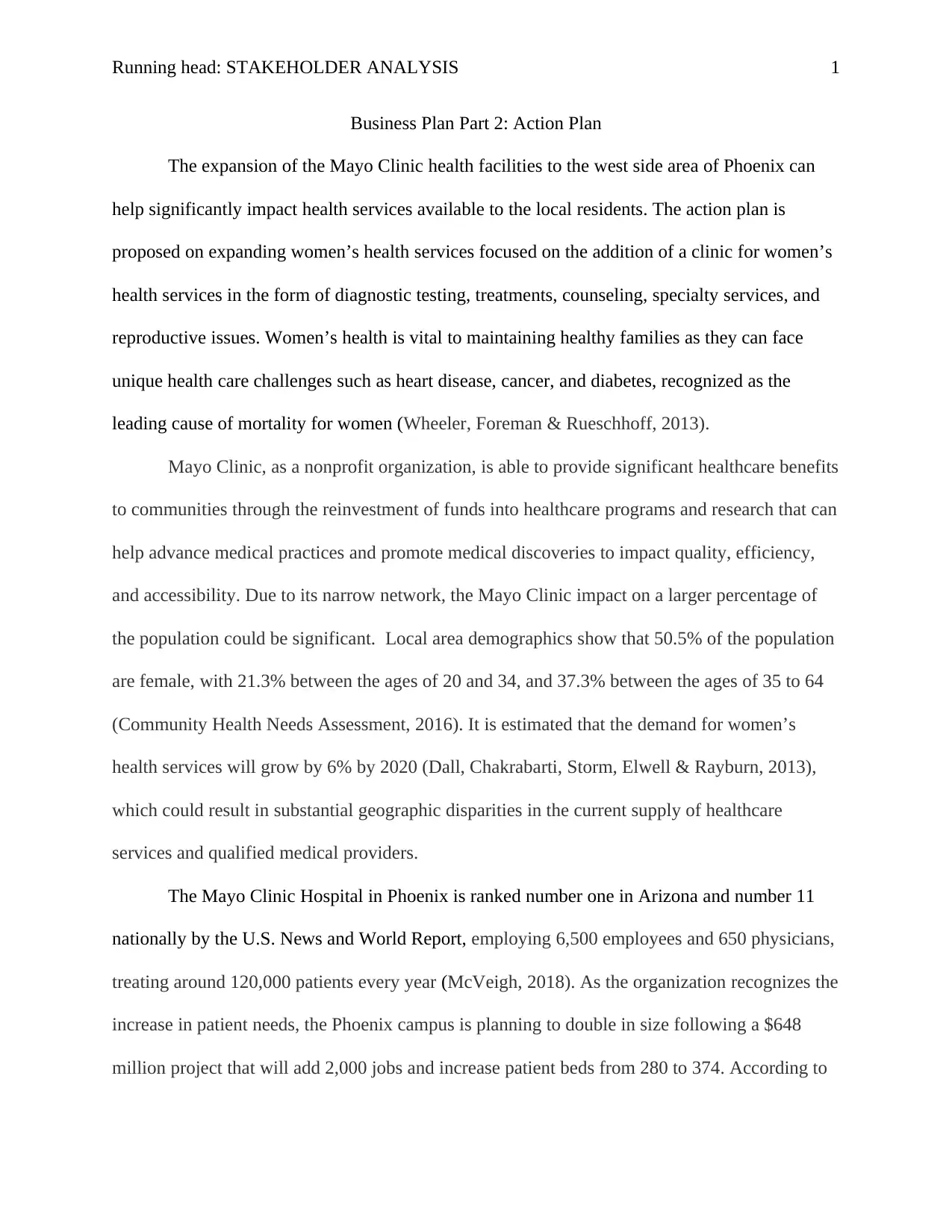
Running head: STAKEHOLDER ANALYSIS
Business Plan Part 2: Action Plan
The expansion of the Mayo Clinic health facilities to the west side area of Phoenix can
help significantly impact health services available to the local residents. The action plan is
proposed on expanding women’s health services focused on the addition of a clinic for women’s
health services in the form of diagnostic testing, treatments, counseling, specialty services, and
reproductive issues. Women’s health is vital to maintaining healthy families as they can face
unique health care challenges such as heart disease, cancer, and diabetes, recognized as the
leading cause of mortality for women (Wheeler, Foreman & Rueschhoff, 2013).
Mayo Clinic, as a nonprofit organization, is able to provide significant healthcare benefits
to communities through the reinvestment of funds into healthcare programs and research that can
help advance medical practices and promote medical discoveries to impact quality, efficiency,
and accessibility. Due to its narrow network, the Mayo Clinic impact on a larger percentage of
the population could be significant. Local area demographics show that 50.5% of the population
are female, with 21.3% between the ages of 20 and 34, and 37.3% between the ages of 35 to 64
(Community Health Needs Assessment, 2016). It is estimated that the demand for women’s
health services will grow by 6% by 2020 (Dall, Chakrabarti, Storm, Elwell & Rayburn, 2013),
which could result in substantial geographic disparities in the current supply of healthcare
services and qualified medical providers.
The Mayo Clinic Hospital in Phoenix is ranked number one in Arizona and number 11
nationally by the U.S. News and World Report, employing 6,500 employees and 650 physicians,
treating around 120,000 patients every year (McVeigh, 2018). As the organization recognizes the
increase in patient needs, the Phoenix campus is planning to double in size following a $648
million project that will add 2,000 jobs and increase patient beds from 280 to 374. According to
1
Business Plan Part 2: Action Plan
The expansion of the Mayo Clinic health facilities to the west side area of Phoenix can
help significantly impact health services available to the local residents. The action plan is
proposed on expanding women’s health services focused on the addition of a clinic for women’s
health services in the form of diagnostic testing, treatments, counseling, specialty services, and
reproductive issues. Women’s health is vital to maintaining healthy families as they can face
unique health care challenges such as heart disease, cancer, and diabetes, recognized as the
leading cause of mortality for women (Wheeler, Foreman & Rueschhoff, 2013).
Mayo Clinic, as a nonprofit organization, is able to provide significant healthcare benefits
to communities through the reinvestment of funds into healthcare programs and research that can
help advance medical practices and promote medical discoveries to impact quality, efficiency,
and accessibility. Due to its narrow network, the Mayo Clinic impact on a larger percentage of
the population could be significant. Local area demographics show that 50.5% of the population
are female, with 21.3% between the ages of 20 and 34, and 37.3% between the ages of 35 to 64
(Community Health Needs Assessment, 2016). It is estimated that the demand for women’s
health services will grow by 6% by 2020 (Dall, Chakrabarti, Storm, Elwell & Rayburn, 2013),
which could result in substantial geographic disparities in the current supply of healthcare
services and qualified medical providers.
The Mayo Clinic Hospital in Phoenix is ranked number one in Arizona and number 11
nationally by the U.S. News and World Report, employing 6,500 employees and 650 physicians,
treating around 120,000 patients every year (McVeigh, 2018). As the organization recognizes the
increase in patient needs, the Phoenix campus is planning to double in size following a $648
million project that will add 2,000 jobs and increase patient beds from 280 to 374. According to
1
⊘ This is a preview!⊘
Do you want full access?
Subscribe today to unlock all pages.

Trusted by 1+ million students worldwide
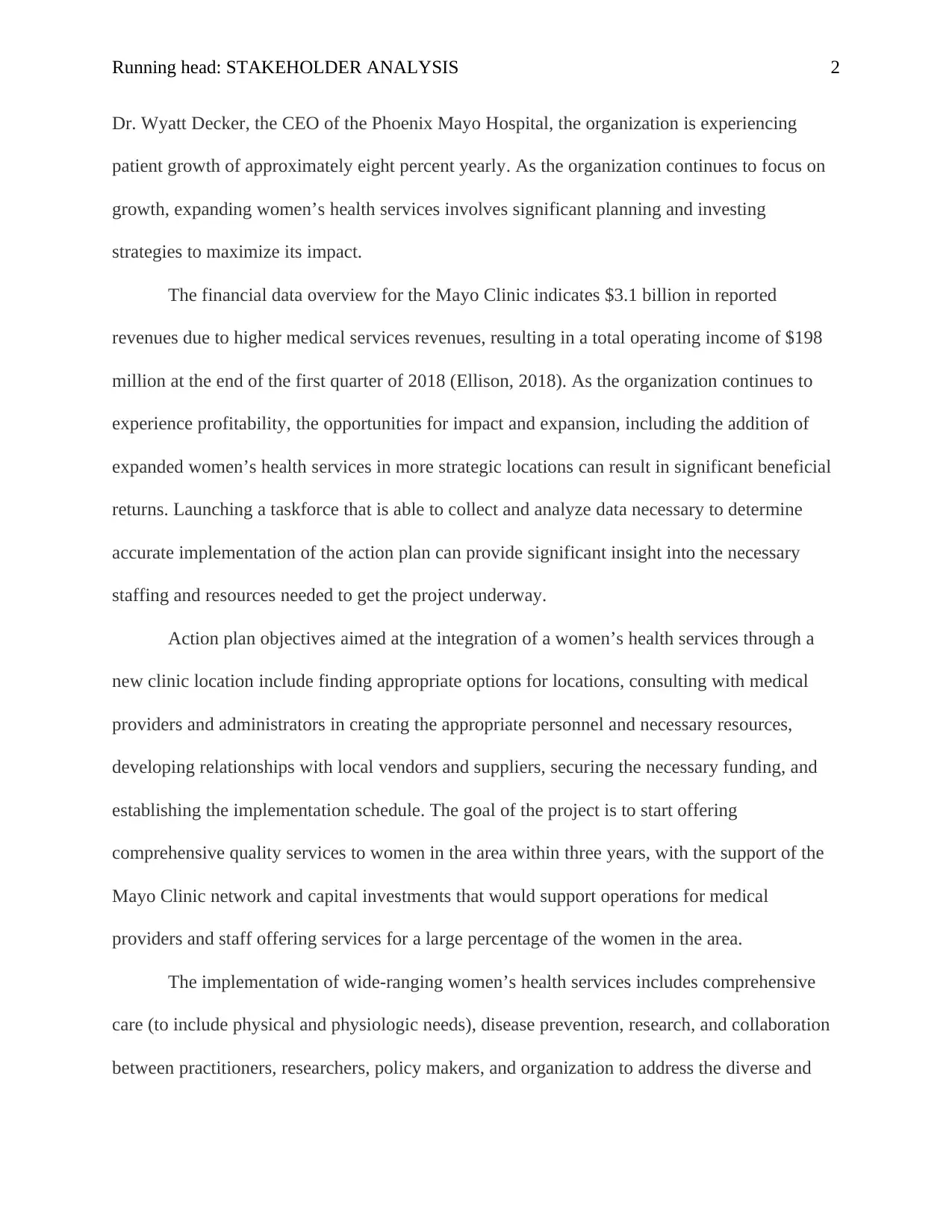
Running head: STAKEHOLDER ANALYSIS
Dr. Wyatt Decker, the CEO of the Phoenix Mayo Hospital, the organization is experiencing
patient growth of approximately eight percent yearly. As the organization continues to focus on
growth, expanding women’s health services involves significant planning and investing
strategies to maximize its impact.
The financial data overview for the Mayo Clinic indicates $3.1 billion in reported
revenues due to higher medical services revenues, resulting in a total operating income of $198
million at the end of the first quarter of 2018 (Ellison, 2018). As the organization continues to
experience profitability, the opportunities for impact and expansion, including the addition of
expanded women’s health services in more strategic locations can result in significant beneficial
returns. Launching a taskforce that is able to collect and analyze data necessary to determine
accurate implementation of the action plan can provide significant insight into the necessary
staffing and resources needed to get the project underway.
Action plan objectives aimed at the integration of a women’s health services through a
new clinic location include finding appropriate options for locations, consulting with medical
providers and administrators in creating the appropriate personnel and necessary resources,
developing relationships with local vendors and suppliers, securing the necessary funding, and
establishing the implementation schedule. The goal of the project is to start offering
comprehensive quality services to women in the area within three years, with the support of the
Mayo Clinic network and capital investments that would support operations for medical
providers and staff offering services for a large percentage of the women in the area.
The implementation of wide-ranging women’s health services includes comprehensive
care (to include physical and physiologic needs), disease prevention, research, and collaboration
between practitioners, researchers, policy makers, and organization to address the diverse and
2
Dr. Wyatt Decker, the CEO of the Phoenix Mayo Hospital, the organization is experiencing
patient growth of approximately eight percent yearly. As the organization continues to focus on
growth, expanding women’s health services involves significant planning and investing
strategies to maximize its impact.
The financial data overview for the Mayo Clinic indicates $3.1 billion in reported
revenues due to higher medical services revenues, resulting in a total operating income of $198
million at the end of the first quarter of 2018 (Ellison, 2018). As the organization continues to
experience profitability, the opportunities for impact and expansion, including the addition of
expanded women’s health services in more strategic locations can result in significant beneficial
returns. Launching a taskforce that is able to collect and analyze data necessary to determine
accurate implementation of the action plan can provide significant insight into the necessary
staffing and resources needed to get the project underway.
Action plan objectives aimed at the integration of a women’s health services through a
new clinic location include finding appropriate options for locations, consulting with medical
providers and administrators in creating the appropriate personnel and necessary resources,
developing relationships with local vendors and suppliers, securing the necessary funding, and
establishing the implementation schedule. The goal of the project is to start offering
comprehensive quality services to women in the area within three years, with the support of the
Mayo Clinic network and capital investments that would support operations for medical
providers and staff offering services for a large percentage of the women in the area.
The implementation of wide-ranging women’s health services includes comprehensive
care (to include physical and physiologic needs), disease prevention, research, and collaboration
between practitioners, researchers, policy makers, and organization to address the diverse and
2
Paraphrase This Document
Need a fresh take? Get an instant paraphrase of this document with our AI Paraphraser
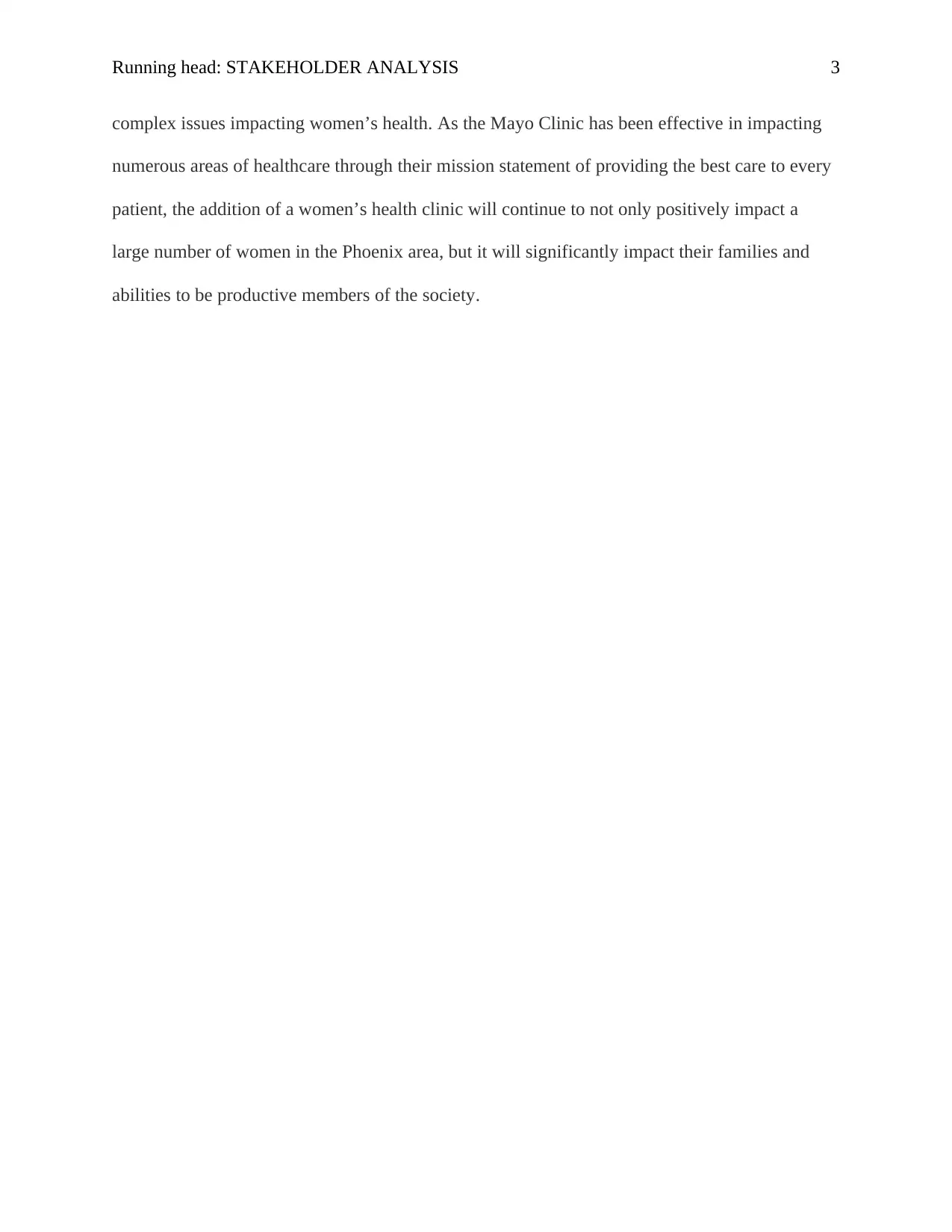
Running head: STAKEHOLDER ANALYSIS
complex issues impacting women’s health. As the Mayo Clinic has been effective in impacting
numerous areas of healthcare through their mission statement of providing the best care to every
patient, the addition of a women’s health clinic will continue to not only positively impact a
large number of women in the Phoenix area, but it will significantly impact their families and
abilities to be productive members of the society.
3
complex issues impacting women’s health. As the Mayo Clinic has been effective in impacting
numerous areas of healthcare through their mission statement of providing the best care to every
patient, the addition of a women’s health clinic will continue to not only positively impact a
large number of women in the Phoenix area, but it will significantly impact their families and
abilities to be productive members of the society.
3
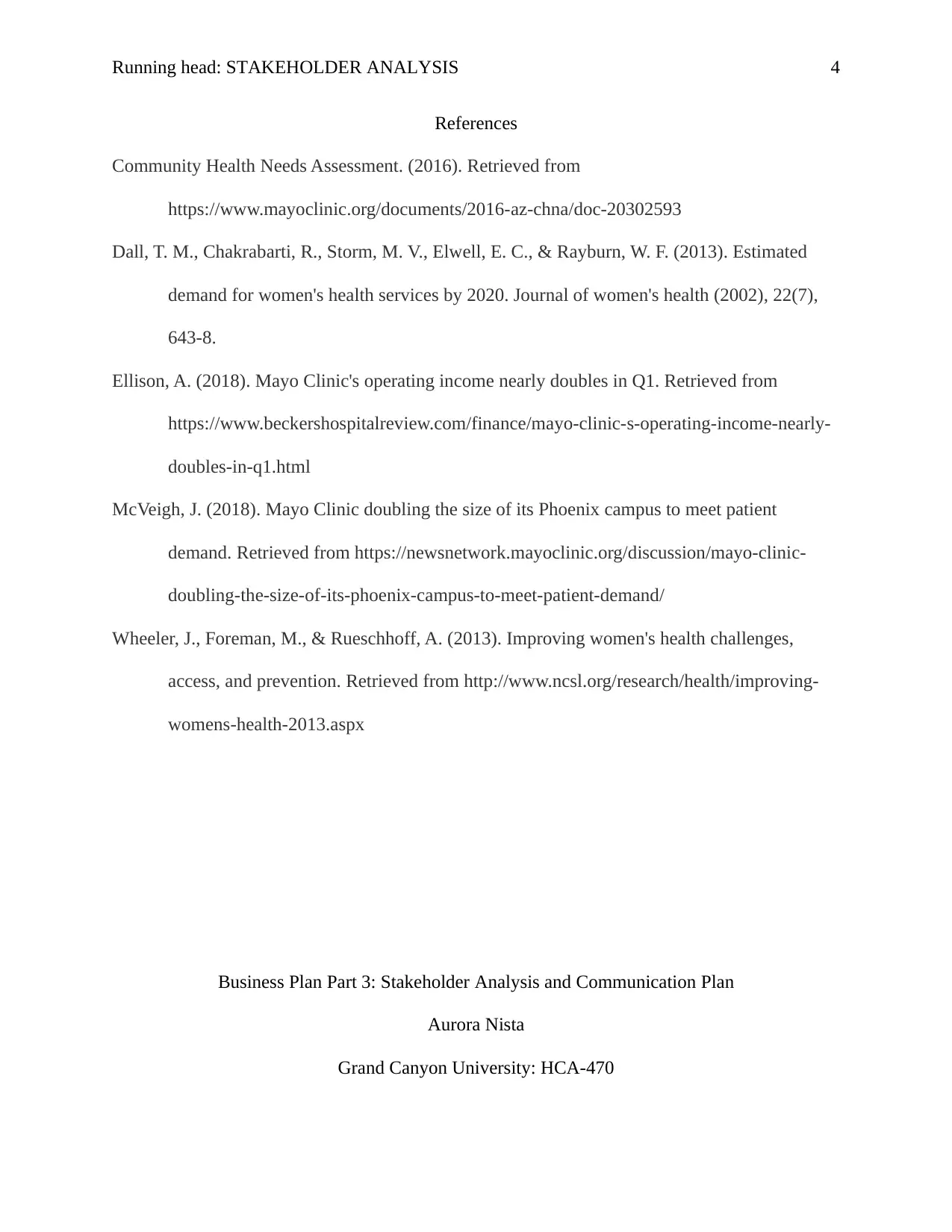
Running head: STAKEHOLDER ANALYSIS
References
Community Health Needs Assessment. (2016). Retrieved from
https://www.mayoclinic.org/documents/2016-az-chna/doc-20302593
Dall, T. M., Chakrabarti, R., Storm, M. V., Elwell, E. C., & Rayburn, W. F. (2013). Estimated
demand for women's health services by 2020. Journal of women's health (2002), 22(7),
643-8.
Ellison, A. (2018). Mayo Clinic's operating income nearly doubles in Q1. Retrieved from
https://www.beckershospitalreview.com/finance/mayo-clinic-s-operating-income-nearly-
doubles-in-q1.html
McVeigh, J. (2018). Mayo Clinic doubling the size of its Phoenix campus to meet patient
demand. Retrieved from https://newsnetwork.mayoclinic.org/discussion/mayo-clinic-
doubling-the-size-of-its-phoenix-campus-to-meet-patient-demand/
Wheeler, J., Foreman, M., & Rueschhoff, A. (2013). Improving women's health challenges,
access, and prevention. Retrieved from http://www.ncsl.org/research/health/improving-
womens-health-2013.aspx
Business Plan Part 3: Stakeholder Analysis and Communication Plan
Aurora Nista
Grand Canyon University: HCA-470
4
References
Community Health Needs Assessment. (2016). Retrieved from
https://www.mayoclinic.org/documents/2016-az-chna/doc-20302593
Dall, T. M., Chakrabarti, R., Storm, M. V., Elwell, E. C., & Rayburn, W. F. (2013). Estimated
demand for women's health services by 2020. Journal of women's health (2002), 22(7),
643-8.
Ellison, A. (2018). Mayo Clinic's operating income nearly doubles in Q1. Retrieved from
https://www.beckershospitalreview.com/finance/mayo-clinic-s-operating-income-nearly-
doubles-in-q1.html
McVeigh, J. (2018). Mayo Clinic doubling the size of its Phoenix campus to meet patient
demand. Retrieved from https://newsnetwork.mayoclinic.org/discussion/mayo-clinic-
doubling-the-size-of-its-phoenix-campus-to-meet-patient-demand/
Wheeler, J., Foreman, M., & Rueschhoff, A. (2013). Improving women's health challenges,
access, and prevention. Retrieved from http://www.ncsl.org/research/health/improving-
womens-health-2013.aspx
Business Plan Part 3: Stakeholder Analysis and Communication Plan
Aurora Nista
Grand Canyon University: HCA-470
4
⊘ This is a preview!⊘
Do you want full access?
Subscribe today to unlock all pages.

Trusted by 1+ million students worldwide
1 out of 17
Related Documents
Your All-in-One AI-Powered Toolkit for Academic Success.
+13062052269
info@desklib.com
Available 24*7 on WhatsApp / Email
![[object Object]](/_next/static/media/star-bottom.7253800d.svg)
Unlock your academic potential
Copyright © 2020–2025 A2Z Services. All Rights Reserved. Developed and managed by ZUCOL.




